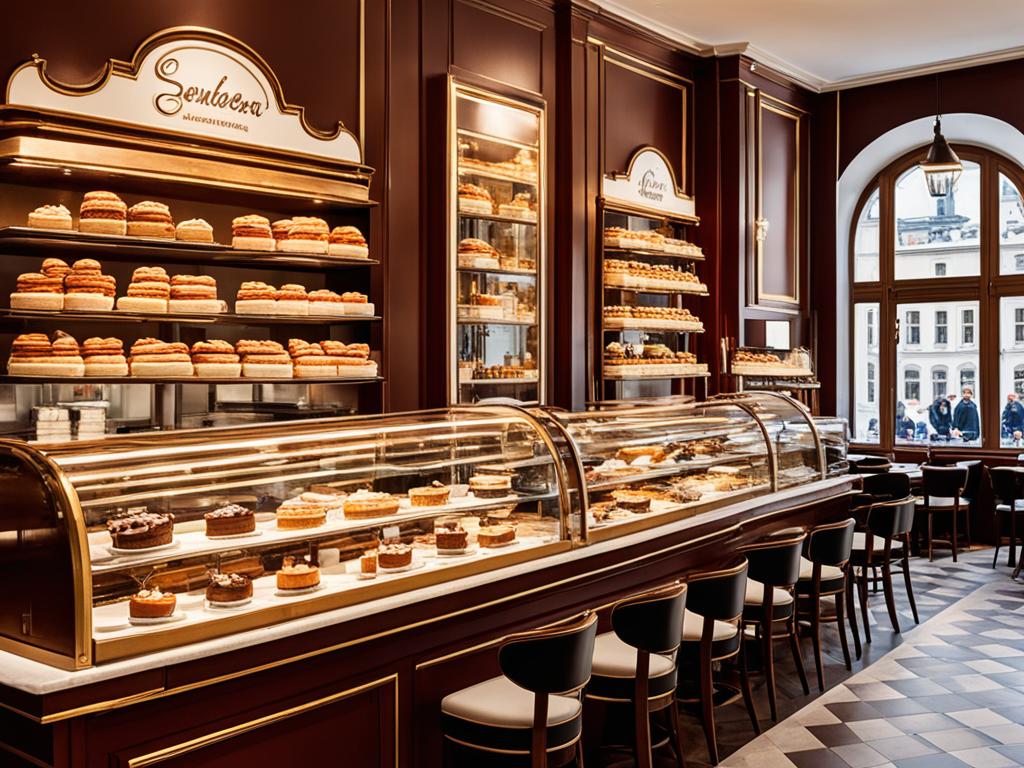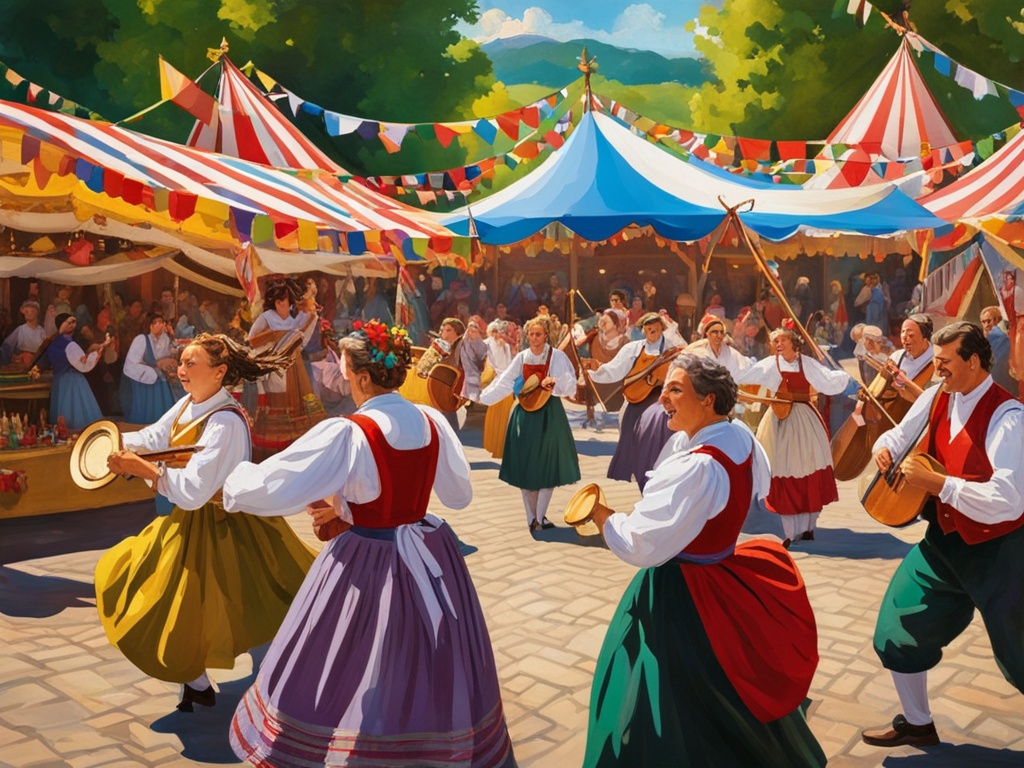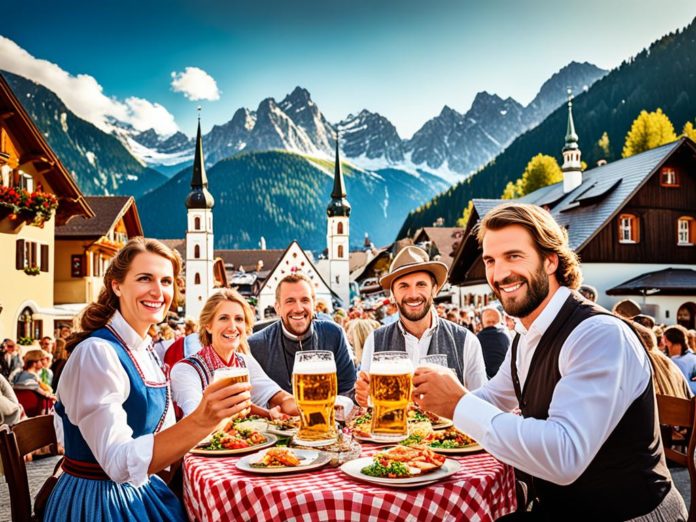Austria is known for its deep cultural roots. These roots come from many groups like the Celtic, Roman, Slavic, and Germanic peoples. The country is famous for its classical music, stunning baroque buildings, and lively coffee culture. It also has a wide range of religious traditions.
Austria’s culture shows many regional differences. Each area has its own way of speaking, customs, food, and buildings. Yet, Austrians feel a strong connection to their national identity and traditions.
Key Takeaways
- Austria has a diverse cultural landscape influenced by various European civilizations.
- The country is renowned for its classical music heritage and iconic composers like Mozart and Beethoven.
- Austrian cuisine and coffee house culture are deeply rooted in the nation’s traditions.
- Austria’s architectural landmarks, including castles and palaces, are renowned worldwide.
- The country’s religious diversity reflects its historical interactions with different faiths.
Introduction to Austrian Culture
Austrian culture has been deeply influenced by its past as a key part of the Austro-Hungarian Empire. This empire once covered much of Central Europe. Today, Austria’s language, religion, and customs show this history. Even though most people call themselves Austrian, there are also Slovenes, Croats, Czechs, Hungarians, and immigrants. These groups add to the Austrian cultural heritage.
Historical Influences
The Austro-Hungarian Empire’s impact is still seen in Austrian culture. The country has many languages because of this history. German is spoken by almost all Austrians. But, there are also Italian, Slovene, Croatian, Hungarian, and Czech speakers in certain areas.
Diversity Across Regions
Austria may be mostly Austrian, but it has many regional cultural differences. The country’s varied landscapes, from the Alps to the east’s hills and vineyards, shape local identities. You can see this in the food, language, and traditions of each region. The Austrian national identity is made up of these varied cultural pieces.
“Austria’s cultural heritage is not a single, monolithic entity, but rather a rich tapestry of diverse regional and ethnic influences that collectively define the nation’s identity.”
Language and Dialects of Austria
The Austrian German language is the main language spoken in Austria, used by over 98% of the people. But, Austria is also known for its regional dialects. These can change a lot in vocabulary and how words are said from one province to another.
In Vienna, there’s a special way of speaking German called Wienerisch. It’s different from what they speak in other parts of Austria. Also, minority languages like Slovene, Croatian, and Hungarian are spoken in certain areas. This is mainly in the southern province of Carinthia, near Austria’s borders.
Austria’s language mix shows its deep history and where it’s located. Each province keeps its own cultural identity. Almost all Austrians speak at least two languages. This shows how much the country values its linguistic diversity.
| Language | Percentage of Population |
|---|---|
| German | 98% |
| Slovene | 0.5% |
| Croatian | 0.1% |
| Hungarian | 0.1% |
The linguistic diversity in Austria makes it proud and rich in culture. It shows the country’s unique heritage and how its people keep their regional identities alive.
“Austria is a country with a rich linguistic tapestry, where the official German language coexists harmoniously with a tapestry of regional dialects and minority languages, each contributing to the nation’s cultural identity.”
Austrian Music and Arts
Austria is known for its deep musical roots, with Vienna at the heart of classical music. Famous composers like Mozart, Beethoven, and Strauss made their mark here. The Vienna Philharmonic and Vienna State Opera are famous around the world. The Vienna Boys’ Choir is also well-known for its beautiful music.
Austria has a lively folk music tradition. This includes the unique sound of Schrammelmusik and the amazing skill of yodeling. Traditional dances like the Ländler and Schuhplattler are key parts of Austrian culture. They are often seen at festivals and celebrations.
“Austria has a musical legacy that is unparalleled, with composers like Mozart and Beethoven leaving an indelible mark on the classical tradition. But the country’s folk music is equally captivating, with the lively Schrammelmusik and the enchanting art of yodeling reflecting the rich cultural tapestry of this alpine nation.”
Austrian Cuisine and Culinary Traditions
Viennese Coffee House Culture
Austrian food is famous for its warm, comforting dishes like Wiener Schnitzel, Tafelspitz, and Sachertorte. The country’s food is shaped by its location and history with the Austro-Hungarian Empire. The Viennese coffee house is a key part of Austrian culture. It has been a place for socializing and deep talks for a long time.
These cafes are cozy, with beautiful designs and a calm vibe. When you visit Vienna, you can dive into the cafe culture. Enjoy rich Viennese coffee and try the famous Sachertorte.
“The Viennese coffee house is a place where time and space are consumed, but only the coffee is found on the bill.” – Karl Kraus, Austrian writer and journalist
The traditional Austrian cuisine offers many hearty dishes that show the country’s rich culture. You’ll find the famous Wiener Schnitzel, the boiled beef Tafelspitz, and the rich chocolate cake Sachertorte. These dishes prove Austria’s top-notch food.

The Viennese coffee house culture has been key to Austrian life for a long time. It’s a place for meeting, deep talks, and enjoying Viennese cafe culture. These cozy cafes are a big part of Austrian cuisine and culture.
Religious Diversity in Austria
Austria is known for its rich mix of religions, with the Roman Catholic Church being a big part of its culture. But, the country also has many other faiths, showing how Austria’s religious scene is changing.
Roman Catholicism
For a long time, Roman Catholicism has been the main religion in Austria. About 64% of people said they were Catholic in 2011. You can see the Church’s impact in Austria’s old buildings, festivals, and customs. But, the number of Catholics has been going down, like in many European countries.
Other Faiths
Austria also has many other religions. Protestants and Orthodox Christians make up about 7% of the population together. Muslims, mostly Turkish immigrants, are 4.2% of the people. There are also Jews, Jehovah’s Witnesses, and others, making up less than 5.5% of the population.
Austria’s laws protect everyone’s right to believe what they want and join any group they like. This means everyone’s faith is safe and respected. It makes Austria known for being open and accepting of all religions.
| Religious Affiliation | Percentage of Population |
|---|---|
| Roman Catholic | 64.1% |
| Protestant | 4.9% |
| Orthodox Christian | 2.2% |
| Muslim | 4.2% |
| Other Religions | 5.5% |
| Unaffiliated | 22.4% |
Austria’s mix of religions shows how open and accepting the country is. Different faiths live together, making Austrian society rich and diverse.
Architecture and Heritage Sites
Austria is famous for its stunning architecture, from grand castles to quaint city centers. Iconic buildings like the Schönbrunn Palace in Vienna and the Hohenzollern Fortress in Salzburg go back to the Habsburg Dynasty days. These sites remind us of Austria’s rich history and its strong cultural identity.
The country’s architecture shows its mix of cultures over the years. The Gothic style is seen in the St. Stephan’s Cathedral in Vienna, known for its tall naves. The Romanesque period left its mark with the Admont Great Bible and the enamel pulpit panels by Nicolas de Verdun.
In the Baroque era, Italian artists brought grand decorations to churches and palaces. The Apotheosis of Hercules by Andrea Pozzo in the Schönbrunn Palace is a prime example. Artists like Johann Rottmayr and sculptors like Georg Raphael Donner added to Austria’s artistic heritage.
The Secessionist Movement in Vienna started in 1897 and brought Art Nouveau to the forefront. Artists like Gustav Klimt, Egon Schiele, and Oskar Kokoschka made their mark with unique styles.
Austria’s architecture and heritage sites showcase its deep cultural roots. From the grand Habsburg architecture to modern art, Austria’s buildings inspire and amaze visitors worldwide.
Traditional Clothing and Attire
Austria’s rich culture shines through its traditional clothing, known as Tracht. The iconic lederhosen for men and the dirndl for women are key examples. These outfits show the unique styles across Austria’s provinces, reflecting local community identities.
The dirndl symbolizes Austrian tradition. It started with Alpine peasants in the 16th to 18th centuries and has grown into a fashion icon. It includes a bodice, skirt, blouse, and apron, with jewelry and floral wreaths adding charm.
Dirndl styles change across regions, with the apron knot’s placement holding cultural meaning. In some places, wearing traditional clothes is key to local customs and celebrations, keeping these identities alive.
Regional Variations
Tracht, Austria’s traditional clothing, highlights the country’s varied regional influences. From the Alps’ lederhosen to the Salzkammergut region’s intricate dirndls, each area has its own style. These styles not only show the local culture but also bring pride to the communities.
| Region | Traditional Clothing | Notable Features |
|---|---|---|
| Tyrol | Lederhosen, dirndl | Lederhosen with intricate embroidery, dirndl with apron and bodice designs |
| Salzburg | Dirndl | Dirndl with floral patterns and lace trimmings |
| Vorarlberg | Dirndl, embroidered hats | Dirndl with distinctive apron designs, embroidered hats with feathers |
| Styria | Lederhosen, dirndl | Lederhosen with leather suspenders, dirndl with bold color combinations |
Keeping these regional styles alive shows Austria’s cultural depth and community pride. Fashion designers updating the classic tracht and dirndl keep Austria’s sartorial heritage alive and interesting.
Festivals and Celebrations in Austria
Austria is full of cultural heritage, shown in its lively festivals and celebrations. The Viennese Opera Ball and the Austrian New Year’s Concert are big events. They let Austrians show off their traditions and welcome visitors to join in the fun.
The Viennese Opera Ball is a big deal in Austria. It happens every year at the Vienna State Opera. This event shows off Austria’s love for classical music, bringing people from all over to see the beauty of the Viennese ballroom.
The Vienna New Year’s Concert is another big tradition. It’s played by the famous Vienna Philharmonic. This event is loved worldwide, thanks to its beautiful classical music.
Outside Vienna, Austria has many festivals that celebrate its varied culture. The Salzburg Festival is a top event. It brings together the best in theater, opera, and classical music, drawing in visitors from everywhere.
| Festival | Location | Description |
|---|---|---|
| Viennese Opera Ball | Vienna | An annual grand ball held at the Vienna State Opera, celebrating the country’s classical music legacy. |
| Vienna New Year’s Concert | Vienna | A globally broadcast concert performed by the Vienna Philharmonic, a cherished part of Austria’s cultural calendar. |
| Salzburg Festival | Salzburg | A prestigious event showcasing the best in theater, opera, and classical music, attracting visitors from around the world. |
These are just a few examples of the many traditional Austrian festivals. They show Austria’s deep cultural roots and the pride Austrians have in their customs and celebrations.

Sports and Outdoor Activities
Austria’s stunning mountains have always inspired and entertained its people. It’s famous for alpine sports like skiing, snowboarding, and mountaineering. These sports are a big part of the Tyrolean Alps’ culture. Besides winter sports, Austrians love outdoor activities like hiking, cycling, and rock climbing. These activities let them enjoy the beauty of their country and are key to their culture.
Alpine Traditions
In Austria, alpine sports and outdoor activities are filled with tradition. The Krampus runs and the game of Eisstockschießen show Austrians’ bond with the Tyrolean Alps. The Rauhnaechte, a twelve-day period after Christmas, is filled with rituals that highlight Austria’s traditions.
- The Krampus tradition shows the battle between good and evil.
- “Räuchern,” or burning incense, during the Rauhnaechte keeps animals safe from harm.
- Mistletoe, a sign of luck, is hung at Christmas, and kissing under it is believed to bring happiness.
These alpine traditions keep Austria’s culture alive. They also keep the bond between the people and the Tyrolean Alps strong through the years.
| Popular Outdoor Activities in Austria | Popularity Rank |
|---|---|
| Skiing | 1 |
| Hiking | 2 |
| Cycling | 3 |
| Snowboarding | 4 |
| Rock Climbing | 5 |
“The mountains are calling, and I must go.” – John Muir
Conclusion
Austria’s culture is rich and complex, showing the country’s deep history and diverse people. It has classical music, baroque architecture, traditional food, and outdoor activities. Each region has its own unique traits that make Austria’s culture special.
The country has changed over time but still holds onto its national identity. It welcomes the traditions of minority groups and immigrants, making its culture vibrant and diverse.
Visitors and locals alike find Austria’s traditions and commitment to diversity fascinating. You can enjoy Vienna’s grand opera houses, taste traditional Viennese coffee, or explore the stunning Alps. Austria’s culture is a mix of many things, offering a unique experience.
Austria’s cultural richness will keep drawing people from all over the world. It will also inspire new generations to appreciate the diverse and unique culture of Austria.
